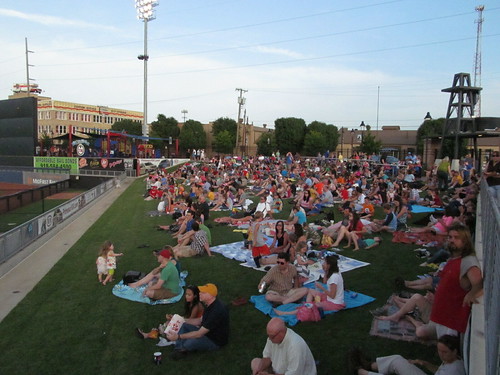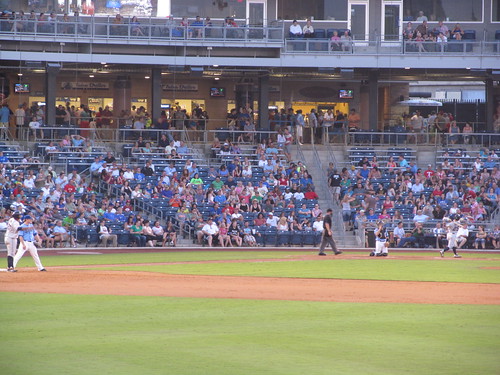Tulsa Downtown: August 2017 Archives
It's a paradox: The Tulsa Drillers, our city's minor league baseball team, appear to be in the best financial shape they've ever been and setting attendance records every year. But when I've attended games in recent years, I've been surprised at the large numbers of empty seats.
Below is a draft of an article I wrote on June 23, 2013, after a visit to the ONEOK Field with my son. I've been back to the park on a number of occasions since then, and my observations stand. Last August, my son and I attended four games during the season's final stretch, during which we observed the large number of empty seats, which suggested an actual attendance -- "butts in seats" -- far below paid attendance, which would include season tickets, whether used or not. The photos below, from that June 2013 game, show far more actual attendees than I've seen at more recent games. I should mention that we haven't been to a game this year, simply because we've been otherwise occupied this summer, but we'll probably try to make a game or two before the season is over.
Today, while running errands, I listened to Jessica Dyer's "Down to Business" show on KRMG, and her guest was Jason George, Executive Vice President of the Tulsa Drillers. It was interesting to hear him talk about the shift in the club's business philosophy with the move from Driller Stadium to ONEOK Field. Although the new park has half the capacity of the old one, the team has more than doubled the size of its permanent staff and increased its seasonal staff as well.
George talked about the decision to end the tradition of Pack-the-Park Night, when free tickets were distributed through QuikTrip, Arby's, and other local sponsors, typically for poorly attended midweek games. Our habit was to pay a few bucks extra per ticket to upgrade those free general admission coupons for reserved or box seats. The full house added to the excitement of being there for the game, and I suspect concession sales went through the roof. The lines were certainly long.
I phoned in with a question, which I relayed to the producer. They had me speak to George off the air, during a commercial break. My question: What could be done to allow people who actually show up to the game to buy good seats? George told me that they couldn't resell a seat that belonged to a season ticket holder. He mentioned that there was a higher retention rate among season ticket holders than at the old park.
George's answers on and off the air, along with my in-person observations, have convinced me that the downtown version of the Tulsa Drillers are no longer about baseball fans watching future major league stars. They are about selling corporate suites and club seats to companies -- selling the skyline as a backdrop to business meetings, and oh, by the way, there are some people playing sportsball on the grassy courtyard nearby.
Most of what I wrote four years ago still holds up, except that, of course, the old park can no longer be a venue for a baseball-fan-focused alternative, thanks to the city's foolish designation of the site for the BMX headquarters before the logistics (e.g., conflicts over "pouring rights") had been ironed out. It's a shame that a beautiful ballpark, ideal for watching the game, built and improved entirely with private funds, is being dismantled in favor of a downtown park funded through taxes and misoriented for baseball.
Tulsa's ONEOK Field is a great place to hang out on a summer evening, people-watch, let your kids splash and climb, and (if you're lucky enough to have infield seats) enjoy the view of the downtown skyline as the sun sets. But as a place to watch a baseball game, it's not nearly as good as the Tulsa Drillers' old ballpark at 15th and Yale.
Friday night I took my seven-year-old son downtown to join my daughter and the church youth group watching the Tulsa Drillers against the Northwest Arkansas Naturals at ONEOK Field.
The youth group had planned to sit on the outfield lawn, but I was considering paying extra for infield seats for me and the boy, so that we could see the state of the game more clearly. When we got to the box office, that wasn't an option. Only the $5 outfield lawn seats were available, and already they were filling up.
That wasn't because the infield seats were full. It looked like at least a third, maybe even half, of the 5,000 seats in the infield were unoccupied throughout the game. Presumably these seats belonged to season ticket holders who opted not to attend that night. I have heard that there are companies that buy season tickets as a business expense for entertaining clients and as a perk for their employees; if they're not needed for that purpose on a particular night, and no employee wants them, the seats go empty.
This was the first game I'd watched at ONEOK Field from the outfield lawn. For other games, I'd had infield tickets from a friend -- second row back from home plate in one case, club seating at other times. (Those seats had a great view of home, but during day games they put you right in the sun. We abandoned the second-row back seats after a few innings, preferring to watch from the shade of the concourse.)
From the outfield lawn, you're 400 feet from home plate. You're scarcely above the level of the players, so you're getting a vertically compressed, cross-section view of the game -- outfielders, infielders, pitcher, catcher, batter, umpire, runners, coaches are all on the same level. The batter, catcher, and home plate umpire seem to blend in to the crowd in the seats behind them. In most stadiums, when you look in from the outfield -- the typical TV camera angle -- you see a wall behind the batter, giving you a fairly clear view.. At ONEOK Field, there are fans sitting at tables right at ground level behind the batter.
From the east half of the right field lawn, you can't see the jumbo scoreboard because of the playground and towering batter's eye screen that protects the kids' splash pad. We could see the numbers on the small scoreboard over the 1st base seats, but it took a while to make out the lettering and figure out which number was which.
Back in 1987, when friends and I went made three trips to old Busch Stadium and had upper-deck outfield seats to watch the St. Louis Cardinals, we would joke that the action on the diamond was so far away that "the game was only a rumor." But at least from that vantage point we could see the movement of the runners and fielders and have an idea of what was happening. Down on the ONEOK Field lawn, we didn't have that consolation.
At the old Drillers Stadium, there really wasn't a bad seat, although that wasn't the case from the beginning. When the first outfield seating was built along the left field foul line, the seats were oriented perpendicular to the foul line, so you had to sit at a sharp angle to the bench to see home. The closest seats to the field were at least 10 feet up. Owner Went Hubbard reoriented the left field seating and built right field seating angled to face the infield. He also dropped the box seats from their lofty perch to a more reasonable height above the field. The orientation of the park allowed the shadows to begin to shade the stands early in the evening. The results were great for watching baseball.
The downtown stadium backers said our old ballpark was too big at 10,950 seats. We needed a smaller, more intimate stadium so that it would feel full most of the time, they said. But how intimate can it feel when half of the seats are empty?
The Drillers should consider some measures that protect season ticket holders, but at the same time fill up the infield seats whenever possible (and as a bonus, make more money).
Since barcode scanners are used to scan every ticket each game, somewhere there's a computer that knows exactly which seats have already been claimed that game. That makes it possible to fill the infield stands without chaos.
The Drillers could offer season ticket holders a credit for notifying the Drillers and releasing their seats when they won't be used. Go to the website or the mobile app, click a button, and the Drillers can credit your account and resell the seat to someone who will actually use it that night.
The Drillers could offer seating upgrades after the third inning; ticket holders in the park could pay to upgrade to any unclaimed seat. Season ticket holders who are running late could notify the Drillers via the web or a mobile app not to release their seats.
As an alternative, maybe someone could bring an independent minor league team to play at the old park. The American Association of Independent Professional Baseball has teams in a number of old Texas League ballparks, including Wichita, Amarillo, and El Paso. A few of the teams manage to thrive playing just a few miles from a major league park -- the St. Paul Saints, the Kansas City T-Bones, and the Grand Prairie AirHogs (their home field, QuikTrip Park, is just seven miles from The Ballpark in Arlington). These teams draw fans who want to see baseball up close at an affordable price. QuikTrip Park, by the way, cost $20 million to build in 2008, and seats about 5500.


